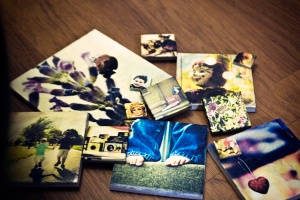Crunchy Betty has this great tutorial about making picture tiles. It uses mod podge, so it’s not archival, but they look really nice. There is a tutorial here, including how to hang them. Tutorial includes pictures.
Category Archives: ideas
Printmaking: Artists working in Etching
Kenji Ushiku, born 1922. Japanese.
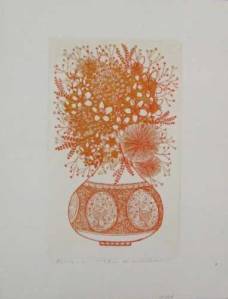
HANA-12-L, ETCHING, 13 X 10
(found here)
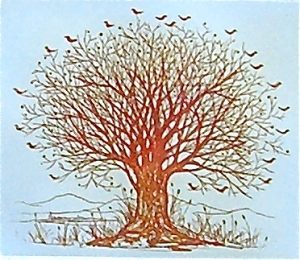
(found here)
Megan Corbett
(website)
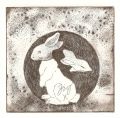
Megan Corbett has created a series of etchings printed on hand made paper and fired clay. The artists’ inspiration evolved from collecting sea weathered china fragments found on beaches around Northland, New Zealand. The collecting of these pieces has become something of a treasure hunt for Megan and she has researched this topic for some years.
The artist has recreated designs from found china fragments onto her own ceramic pieces and zinc etching plates. The purpose of the work is to draw attention to ceramic sherds as an historical fragment of New Zealand’s colonial history.
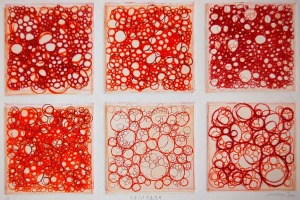
Madeline Adams
O,R,1,2,4,6,7,9 – AP, 2006
Etching/Drypoint, 9 x 14″, page: 11 x 15″
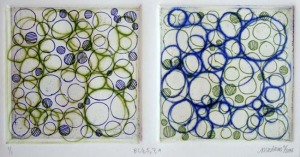
Bl,G,5,7,a, 2008
Etching/Drypoint, 4 x 9″
This isn’t an etching, it’s sharpie on paper, but I really like it:
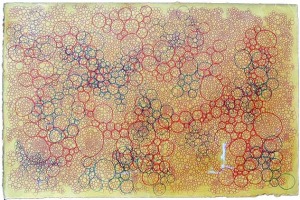
Layers, 2005
Sharpie on paper, 15 x 22″
I don’t know if this actually is an etching, but it looks like one. It’s the album cover for the band Mountains in their album “Etchings”.
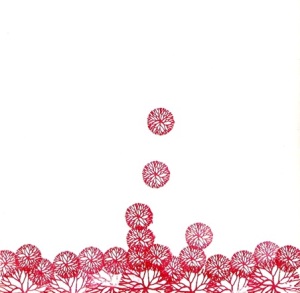
Photoshop image stacking
This technique can be used in a lot of ways to communicate fracture, motion, time lapse and distortion from multiple images into a single image. Some examples:

Smeared Skies made from hundreds of stacked photographs by Matt Molloy

(Matt Molloy)
Time Collapse: How time-lapse photography led to turning stacks of frames into a single image
Molloy talks about his process with stacking. He uses an automated script to stack his photos (called advanced stacker (more about advanced stacker here) and applies lightening techniques usually employed with star trail photography like the tutorial here talks about. See photos here and here
I found this process while trying to remember something I wrote about in response reading [Lucy Soutter, “The Collapsed Archive: Idris Khan,” review of Idris Khan at Victoria Miro Gallery, London, Source, no. 49 (Winter 2006): 46-47.] (I wrote about this here in August 2011. I guess this imagery really stayed with me. was also, very specifically thinking about Bernd and Hilla Becher’s typologies that Khan collapsed into a single image.
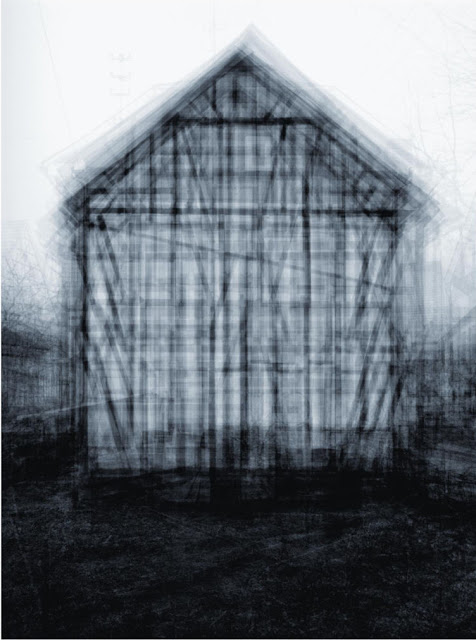
Every… Bernd And Hilla Becher Gable Side Houses 2004
Photogrphic print 208 x 160 cm
Since 1959 Bernd and Hilla Becher have been photographing industrial structures that exemplify modernist engineering, such as gas reservoirs and water towers. Their photogrphs are often presented in groups of similar design; their repreated images make these everyday buildings seem stragely imposing and alien. Idris khan’s Every… Bernd And Gilla Becher series appropriates the Bechers’ imagery and compiles their collections into sing super-images. Inthis piece, multiple images of American-single gabled houses are digitally layered and super-imposed giving the effect of an impressionistic drawing or blurred film still. (source)

<p align right="Every… Bernd And Hilla Becher Prison Type Gasholders 2004
Photographic print 208 x 160cm
The structure in the Bechers’ original photographs are almost identical, though in Khan’s hands the images’ contrast and opacity is adjusted to ensure each layer can be seen and has presence. Though Kahn works in mechanised media and his images are of industrial subjects, their effect is of a soft ethereal energy. They exude a transfixing spiritual quality in their densely compacted details and ghostly outlines. … Prison Type Gasholders conveys a sense of time depiicted in motion, as if transporting the old building, in its obsolete black and white format, into the extreme future. (source)</a
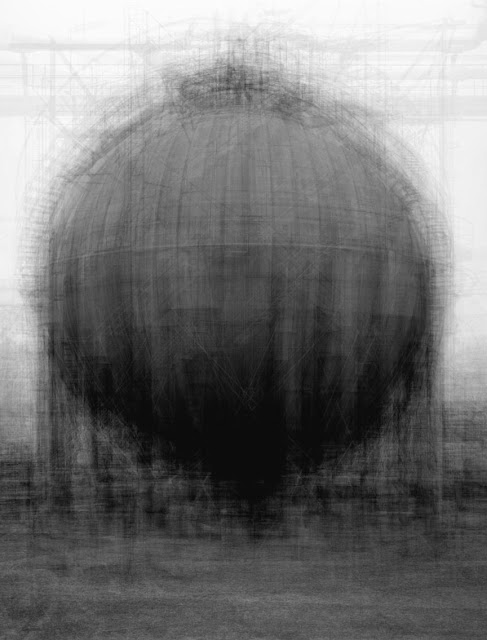
Every… Bernd And Hilla Becher Spherical type Gasholders 2004
Photographic print 208 x 160cm
The Bechers took their photos as a means to document a disappearing tradition;
by grouping them according to ‘typology’ the buildings’ designs function like archetypal symbols or an architectural language. Through Khan’s translucent aggregations, structures such as ….Spherical Type Gasholders lose their commanding simplicity and rigid formalism and descend into fractured and gestural blurs. Through his photographs Khan compresses the timelind of repetition into indivisible subsuming moments and creates a poetic mutability from the fixed codes of history. (source)</a
Snippets from readings to build on later.
Concerning Portrait Photography and its history:
“Look at the plates reproduced in this chapter. Notice how repetitious they arc. Heads and shoulders, as if those parts of our bodies were our truth”
“…It summoned up a complex historical iconography and elaborate codes of pose and posture readily understood within the societies in which such portrait images had currency. The head-on stare, so characteristic of simple portrait photography, was a pose which would have been read in contrast to the cultivated asymmetries of aristocratic posture so confidently assumed by Nadar’s Portrait of Rossini. Rigid frontality signified the bluntness and ‘naturalness’ of a culturally unsophisticated crass and had a history which predated photography. ”
“….the head-on view had become the accepted format of the popular amateur snapshop, but also of photographic documents like prison records and social surveys in which this code of social inferiority framed the meaning of representations of the objects of supervision or reform. ”
“The portrait is therefore a sign whose purpose is both the description of an individual and the inscription of social identity. But at the same time, it is also a commodity, a luxury, an adornmcnt, ownership of which itself confers status.”
-John Tagg, The Democracy of the Image
Expanding on this, particularly the first sentence for reading questions:
A portrait, according to John Tagg in his essay The Democracy of the Image, is a “sign whose purpose is both the description of an individual and the inscription of social identity.” Tagg also says that “at the same time, [the portrait photograph] is also a commodity, a luxury…[the] ownership of which itself confers status.”
Tagg speaks about the formal portrait, a shot of head and shoulders “as if those parts of our bodies were our truth”. Think about taking a portrait, though. Say, your senior yearbook photo. You go into a room that is not yours, under lighting that is not natural, sit in a way that you never sit, directed to tilt your head or body just so. There is no truth in this at all, and yet the resulting image, which goes in yearbooks and in frames in homes, is considered “you”.
Throw them in the air, paste them back together.
I was going through old notepad notes on my phone and I found this note of random things from last semester:
Accuwire
Naked lunch
Throw them in the air paste them back together
Hennessy
Millenials
I don’t know what some of these were about, but the bolded one stands out to me as an interesting way to work on presenting the idea of dissociating from the body.
Print the work, then cut it into strips, paste those strips back together. Potentially, it could be scanned and reprinted as one image but I might need a really big scanner for that. There are digital alternatives, as well. Some glitching does the digital version of tossing something into the air and then pasting the sections back together. This is something to consider when working – something more than just the photography to capture the meaning since I’m struggling with ways to show that visually in a photograph.
Never not broken.
I was reading this article: Why Lying Broken in a Pile on Your Bedroom Floor is a Good Idea that talks about Akhilandeshvari – the Always Broken Goddess from Hindu mythology.
t’s the kind of broken that tears apart all the stuff that gets us stuck in toxic routines, repeating the same relationships and habits over and over, rather than diving into the scary process of trying something new and unfathomable.
Akhilanda derives her power from being broken: in flux, pulling herself apart, living in different, constant selves at the same time, from never becoming a whole that has limitations.
But look, Akhilanda says, now you get to make a choice. In pieces, in a pile on the floor, with no idea how to go forward, your expectations of the future are meaningless. Your stories about the past do not apply. You are in flux, you are changing, you are flowing in a new way, and this is an incredibly powerful opportunity to become new again: to choose how you want to put yourself back together. Confusion can be an incredible teacher—how could you ever learn if you already had it all figured out?
This goddess has another interesting attribute, which is, of course, her ride: a crocodile.
Crocodiles are interesting in two ways: Firstly, Stoneberg explains that the crocodile represents our reptilian brain, which is where we feel fear. Secondly, the predatory power of a crocodile is not located in their huge jaws, but rather that they pluck their prey from the banks of the river, take it into the water, and spin it until it is disoriented. They whirl that prey like a dervish seeking God, they use the power of spin rather than brute force to feed themselves.
By riding on this spinning, predatory, fearsome creature, Akhilanda refuses to reject her fear, nor does she let it control her. She rides on it. She gets on this animal that lives inside the river, inside the flow. She takes her fear down to the river and uses its power to navigate the waves, and spins in the never not broken water. Akhilanda shows us that this is beautiful. Stoneberg writes:
Akhilanda is also sometimes described in our lineage like a spinning, multi-faceted prism. Imagine the Hope Diamond twirling in a bright, clear light. The light pouring through the beveled cuts of the diamond would create a whirling rainbow of color. The diamond is whole and complete and BECAUSE it’s fractured, it creates more diverse beauty. Its form is a spectrum of whirling color.
That means that this feeling of confusion and brokenness that every human has felt at some time or another in our lives is a source of beauty and colour and new reflections and possibilities.
If everything remained the same, if we walked along the same path down to the river every day until there was a groove there (as we do; in Sanskrit this is called Samskara, habits or even “some scars”), this routine would become so limited, so toxic to us that, well, the crocs would catch on, and we’d get plucked from the banks, spun and eaten.
So now is the time, this time of confusion and brokenness and fear and sadness, to get up on that fear, ride it down to the river, dip into the waves, and let yourself break. Become a prism.
All the places where you’ve shattered can now reflect light and colour where there was none. Now is the time to become something new, to choose a new whole.
But remember Akhilanda’s lesson: even that new whole, that new, colourful, amazing groove that we create is an illusion. It means nothing unless we can keep on breaking apart and putting ourselves together again as many times as we need to.
We are already “never not broken.” We were never a consistent, limited whole. In our brokenness, we are unlimited.
It’s only after you’ve lost everything that you’re free to do anything. (Fight Club)
This kind of broken freedom, total destruction, rock bottom – things can’t go any further down, so they can only go up mentality really fascinates me. I’ve spent a lot of time in my life at rock bottom, a lot of time with paralyzing, crippling anxiety. Sometimes making a breakthrough to positivity is scary because you are healing, less broken, and you can fall again. You can get hurt again. Being broken has a certain kind of freedom that allows you to learn and grow.
You are what you eat.
If everything you said/did was written/painted on your body would you watch what you say/do? – smiles515
This seems like an interesting interpretation of identity, taking the spin of “what you do and say makes you who you are. I think I might be interested in recording myself for a day and writing everything I say on myself and photographing it. That’s only one piece, though. I wonder how I could space it out or make it more involved.
Reassembled
Justin Myer Staller
Assembled Plates
printed with Akua Intaglio Ink

“Marge” Twenty plates inked (bigger)
and reassembled into the full image.

“Bridge St.” Seven plates
assembled on the press bed.
Justin Myer Staller is a printmaker living in Philadelphia. He is an adjunct professor of printmaking at Arcadia University and is a member of Space 1026. Justin completed his BA from Penn State University and his MFA from the Rochester Institute of Technology.
Information retrieved from: Akua
This is a really interesting technique to work with, particularly in a self portrait when talking about a fragmented identity. It might be interesting to do some experiments in this style with c-printing from a single negative onto multiple pieces of paper. I think I have some 8×10 left from last semester that I could work with if I shot a roll. Something to consider.

